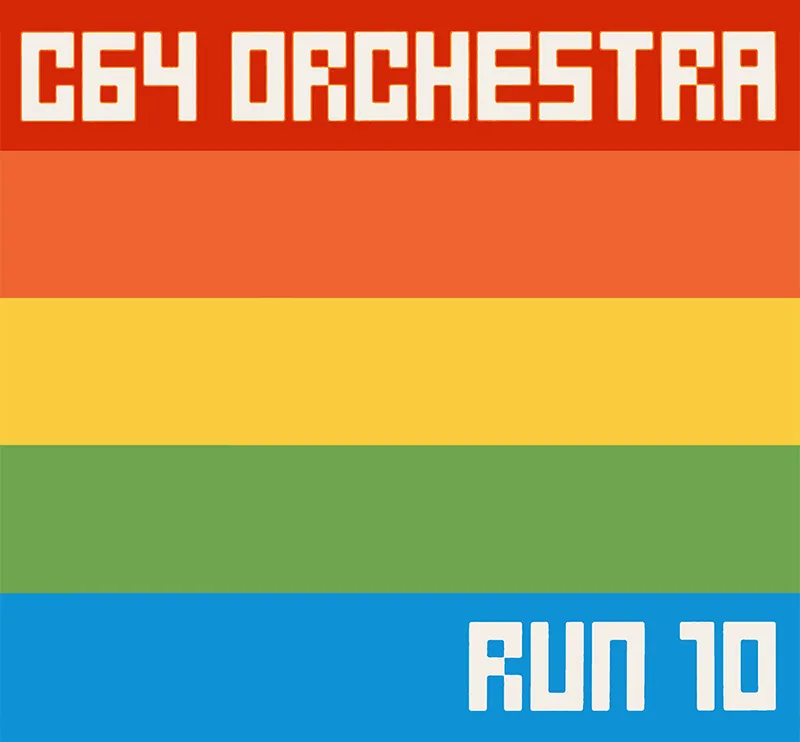C64 Orchestra: RUN 10 - Review by LaLa

Video Games Liveand
PLAY! - A Video Game Symphonyattest to it, they are as popular as ever. However, not only is this the first ever orchestra remix album completely devoted to SID tunes, but it was all arranged by none other than Rob Hubbard himself!
My excitement grew further when I took its very unique box in my hand: it mimics the breadbox design of the Commodore 64 very nicely and the cardboard CD slides out of it like a floppy disc. Or at least, that was the theory. In reality, the box has a very narrow opening and I literally had to use pliers just to get the cardboard out, which took me a good ten minutes of struggling with both while trying not to damage either. That was not fun. Now I don't even dare to put the cardboard back into the box. So, plus points for the design idea, many minus points for usability.
The cardboard cover actually hides two CDs in it: the first one contains the orchestral arrangements of classic SID tunes, the second one contains the original SID tunes themselves, plus a bunch of welcome extras, like interviews with Rob Hubbard and Jeroen Tel, and a trailer video for the album. It also contains a nice fold-out poster that pays homage to the 80s era the Commodore 64 was born in.
I am a bit confused about the inclusion of the second CD, though. It appears to me that their target audience was the SID enthusiasts, in which case simply including the original SID files themselves in the extras or even just a link to the HVSC would've sufficed. If even that - I'm sure SID fans already have all this in their possessions, so putting them on an extra audio disc seems pointless to me.
As for the actual music itself, those looking for that big philharmonic orchestra sound will be disappointed: this is a chamber orchestra playing throughout the album. This results in a much less grandiose style lacking the complexities of a symphonic orchestra, however, the Ricciotti Ensemble provides an impeccable and perfect performance on the album. As a side-note, do check out the Ricciotti Ensemble's homepage and their performances captured on video - they seem to be the most unusual and most casual chamber orchestra's I've ever had the fortune of seeing, even doing
flash mobtype unannounced guerrilla performances! It looks like a ton of fun!
The album opens with Jeroen Tel's
Cybernoid II. It is masterfully arranged in every respect, I especially like the nice quiet parts which sound beautiful. But I think it'd need a big orchestra to bring out this arrangement's full power, which is especially apparent in the fast-paced complex parts of the tune. Even on this very first piece - which I think is not a particularly good fit for a chamber ensemble - it's immediately apparent that the musicians are all masters of their arts and the high quality of craftsmanship continues throughout the album.
Next up is
One Man and His Droidby Rob Hubbard. The arrangement was obviously tailored for this orchestra, dare I say, it's a bit simplified from the C64 version to make it fit for this chamber ensemble. Yet again, some of the more powerful parts don't sound as energetic as I expect them. In fact, I would've been perfectly happy with a full-length mellow version here.
Track number three is
Supremacy, originally composed by Jeroen Tel. I always heard a semi-orchestral arrangement in my mind when listening to this tune, so I looked forward to hearing it here. Again, from a musical standpoint, the arrangement is tailored spot-on for the performing ensemble: it's alternating between baroque style bridges and classic orchestral parts, all masterfully woven together. However, I think the complete lack of percussion is hurtful here, even a single timpani would've enhanced it greatly.
Then comes Hubbard's
Delta High Score. It turns out it's a perfect fit for this orchestra, it sounds as good as it can. The arrangement is excellent and faithful to the original SID, nothing to complain about here!
Hawkeye, originally composed by Jeroen Tel has, inexplicably, some really bad sounding (maybe synthesized?) claps both in the introduction and towards the end. This is more puzzling considering none of the other pieces on the album contain any kind of percussion. But the lack of heavy percussion is less apparent on this track: the arrangement has a very nice flow to it without them. I love the pizzicatos in this tune, they are a very nice touch. The cello and violin parts are also beautiful and performed with lots of emotions and I wish it had more of that powerful brass in there.
However, the arrangement is perhaps a touch too soft in
Myth. Maybe bringing the tempo down would've helped in that matter. The simplifications that were made for this arrangement seem to take away from the original tune rather than enhance it, even during the forte parts of the tune, thus it has less impact on me.
Because the arrangement of the introduction to
International Karatekeeps the oriental nature of the original tune, switching some of the instruments to oriental ones would've helped its case immensely. However, it does conjure up images of Puccini's
Madame Butterflyas it's trying to keep to the spirit of the C64 game it was originally composed for. The introduction then quietly slips into something more modern: much of it sounds contemporary similar to Bartók, which I think adds a really interesting new dimension to this SID classic. The arrangement diverges from the original the most on this track on the album, but that's what makes it really unique and outstanding.
Picking
Master of Magicwas an obvious choice for a chamber orchestra, the original SID being highly symphonic itself. Here it sounds like a soft dream or a fantasy in pink, completely in contrast with the original game's darker tone, but it works great. It's beautifully arranged, performed perfectly with lots of emotional content - it's definitely a highlight of the album.
Like
Cybernoid IIbefore it,
Commandois another questionable choice for this orchestra. It's ambitiously arranged with the high score tune craftily weaved into the middle of it which I think is the one they should've focused on instead, because it is one of the best covers of that tune ever. It is framed by the main tune of
Commandothat I am less impressed with, it just doesn't seem to gel as a whole. Maybe keeping the original's tempo was a mistake, maybe the lack of percussion is what I am missing, but it's just not as strong as some other pieces on this album.
Then we arrive to
Monty on the Run, a classic Hubbard composition. It starts with an excellent introduction and the fast-paced and skillful violin lead is breathtaking. It's all wrapped up in a very smart arrangement that takes into account the nature of the orchestra (unlike, say,
Cybernoid IIdid). Especially towards the end of it Rob Hubbard took some liberties with the original composition and it really works to its advantage, making it a very enjoyable and uplifting piece to listen to, so much so that it is one of my favorite tracks on the album.
I would like to mention that there's also a bonus live (read: non-studio) performance of
Monty on the Runon the second CD. The human orchestra is backed up by the wonderful orchestra of the original SID sounds conducted by Rob Hubbard. The two of them carry out a wonderful conversation throughout the piece, perfectly complementing each other along the way which is sure to bring a smile to many SID fan's face.
The album is a very nice tribute to the SID chip and the two legendary composers, Rob Hubbard and Jeroen Tel, who made it sing to us so wonderfully. Most of the pieces are fairly faithful orchestral reproductions of the original tunes, but its shining moments come with those pieces where the original arrangements were altered to fit the instrumentation of the Ricciotti Ensemble.

Having said that, at times it is painfully apparent that these arrangements need a bigger orchestra and a bigger sound. Except in a few cases what they really need is percussion: timpani, drums, xylophone, triangle - anything to provide some sense of rhythm. It is especially apparent on such fast-paced tunes as
As it stands, I admire the ambitious arrangements and the skillful musicians who performed them, but as I listened to it I couldn't help but wonder about the hidden potential of this album: what if this was all performed by a full-blown symphonic orchestra?…
Cybernoid IIand
Commando- the dynamics is there, but the power isn't, and so they sound relatively thin. Maybe choosing less
bombastictunes and more mellow ones like
Delta High Scoreand
Master of Magicwould've been a better fit for this orchestra, or maybe if they enhanced their sound with synthesizers, it would've helped immensely.
As it stands, I admire the ambitious arrangements and the skillful musicians who performed them, but as I listened to it I couldn't help but wonder about the hidden potential of this album: what if this was all performed by a full-blown symphonic orchestra?…











